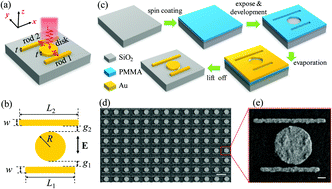Double Fano resonances in hybrid disk/rod artificial plasmonic molecules based on dipole-quadrupole coupling†
Abstract
Fano resonance can be achieved by the destructive interference between a superradiant bright mode and a subradiant dark mode. A variety of artificial plasmonic oligomers have been fabricated to generate Fano resonance for its extensive applications. However, the Fano resonance in plasmonic oligomer systems comes from the interaction of all metal particles, which greatly limits the tunability of the Fano resonance. Besides, only a single Fano resonance is supported by many existing plasmonic oligomers, while multiple Fano resonances mostly occur in complex and multilayer structures, whose fabrication is greatly challenging. Here, a simple asymmetric plasmonic molecule consisting of a central metal disk and two side-coupled parallel metal rods is demonstrated. The simulation and experimental results clearly show that double Fano resonances appear in the transmission spectrum. In addition, the two Fano peaks can be independently tuned and single/double Fano peak switching can be achieved by changing one rod length or the gap distances between the rods and the disk. The modulation method is simple and effective, which greatly increases the tunability of the structure. The proposed asymmetric artificial plasmonic molecule can have applications in multi-channel optical switches, filters and biosensors. Moreover, the controllable plasmonic field intensity in the gap between the disk and rods also provides a new control means for plasmon-induced photocatalytic reactions and biosynthesis.



 Please wait while we load your content...
Please wait while we load your content...